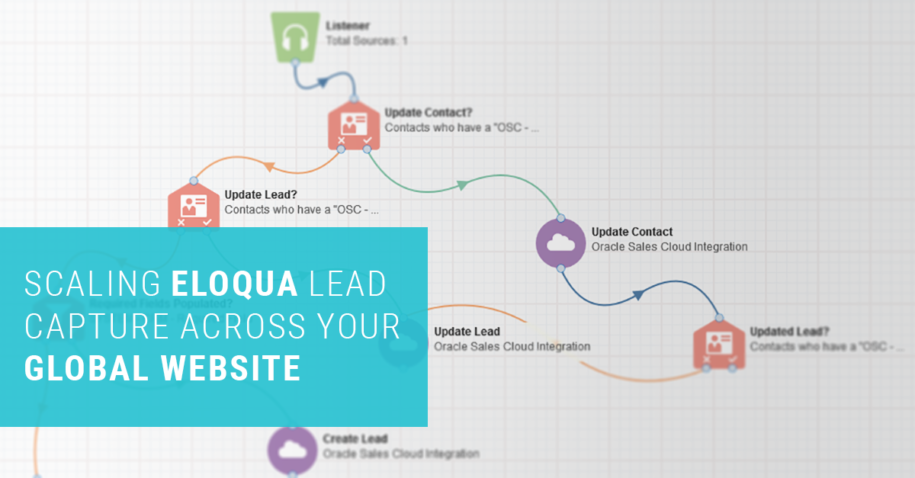In the modern digital world, web contact forms remain the preeminent means for capturing leads. Additionally, their back-end algorithms provide other essential marketing data governance functionality, such as cleaning data, segmenting data, and even measuring the ultimate effectiveness of a campaign. This makes the scaling of web-based lead capture critical to any data-driven marketing effort.
Many companies are already using Eloqua, the industry leading Marketing Automation Platform to deploy forms and landing pages to supercharge their marketing. Eloqua helps organizations thrive in an era where generating new leads from your own web environment is of utmost importance. This trend has to incorporate the latest global privacy considerations when capturing data in order to create actionable leads. Ultimately, learning how to scale this process becomes essential to gain a competitive advantage in any industry.
The challenges of scaling lead capture
Understanding the complexities of scaling Eloqua forms becomes more apparent when you break apart the steps required to deploy best practice lead capture. Development using both Eloqua and HTML creates the forms, their layout, and the underlying web scripting routines. A team made up of business, technical, and marketing personnel collectively handles this work.
Scaling this effort becomes difficult for companies trying to manage hundreds of forms. Risks abound, including process bottlenecks and an inability to maintain sufficient marketing data governance.
The effort only grows in complexity when adding in legal and global considerations. For example any web form must be able to capture a lead from any country. This includes the internationalization of all forms, with the ability to produce standardized marketing data and specific privacy consent verbiage no matter the location of the end-user.
To summarise, the global challenge of lead capture includes:
- Ensuring all forms on your website capture leads from any country.
- Standardizing marketing data no matter the language.
- Utilizing consistent data privacy models and consent processes for applicable countries.
- Getting the various stakeholders to agree on form design and processing.
- Enabling marketers to deploy form designs without IT bottlenecks
- Creating standards and best practices for lead forms and back-end processes.
Create a standard processing path in Eloqua
Creating forms to gate your high value assets in Eloqua is relatively easy. However scaling a one-form to one-asset approach across a global website in multiple languages is problematic. Creating Eloqua forms for each language version of each high value asset you want to gate creates huge in-efficiencies. Even a modest number of gated downloads can scale into a management nightmare for web and marketing automation developers.
For organizations with hundreds of forms, a more manageable technique is to deploy a single master Eloqua form and direct all your website based forms through this standard data collection point. This de-couples the data collection and processing actions within Eloqua from the front-end form experience your web users see. This allows you to take greater control and governance of that experience and hence greater control of your data standards.
Data submitted from the front-end forms is pushed into the back-end Eloqua forms. The processing of the data within Eloqua is determined based on the processing steps in the master form. This approach adds huge efficiency to the deployment and management of lead generation forms; allowing marketers to accomplish more with less effort.
Advanced Eloqua form processing techniques
Once you have established a central processing workflow in your Eloqua forms you can introduce some more advanced techniques.
Hidden values in your front-end forms can be used to trigger specific processing actions. For example, sending an email address value in a hidden field could trigger the action of sending an internal notification email to that address. Other standard actions you can trigger using this approach include sending an auto-responder email, placing leads in a shared list or sending leads into 3rd party apps (for example Webinar or Event platforms).
For fringe use cases where complicated processing steps are required off the back of a specific web form, re-posting the submission to another Eloqua form provides more flexibility.
Another advanced technique is to capture marketing attribution information consistently within your submissions. Attribution measurement allows you to see what marketing tactics are driving leads (and ultimately sales). The standard method of capturing this is using UTM query string parameters on your inbound links (i.e. links from paid media or social ads). The UTM values are captured in the web page and passed into the forms at the point of submission.
In your master form in Eloqua you can process those UTM values to store first and last touch values i.e. the first and last campaigns that drove a user to complete a form. For multi-touch reporting send all your form submissions into an Eloqua CDO (custom data object). CDO data can be pulled from Eloqua into reporting platforms or big data tools for in-depth analysis.
Considerations for Eloqua web form maintenance
Once Eloqua forms become an important part of your company’s automated marketing, maintenance requires some consideration. As marketing requirements or data capture needs change, updates to Eloqua forms can become resource intensive and introduce risk of data loss.
Building forms through a standard infrastructure as we’ve described above combined with an element of front end templating allows global updates and tweaks in a scalable way. An additional benefit to this approach allows experimentation with form layouts or tracking routines. Learnings can be quickly adopted across the business without dealing with IT bottlenecks.
Adopting these approaches with Eloqua will allow your company to truly embrace an agile marketing process. Using your website to turn leads into customers becomes second nature.
GatedContent.com are experts in Eloqua lead capture and help organizations take full advantage of data-driven marketing. For additional insights on the best practices for scaling lead capture, check out the white paper on Progressive Profiling Forms in Marketing Automation and our Marketing Ops Guide to Web Conversion Optimization.
